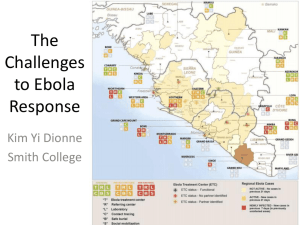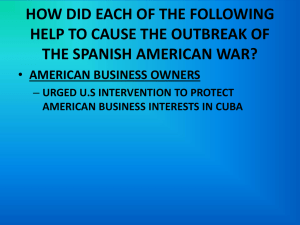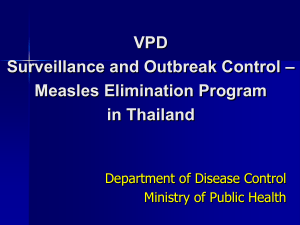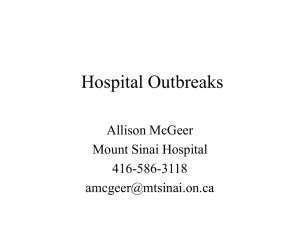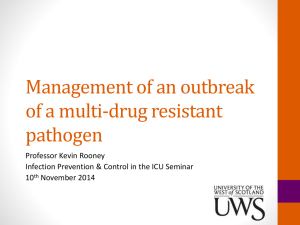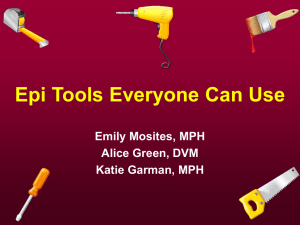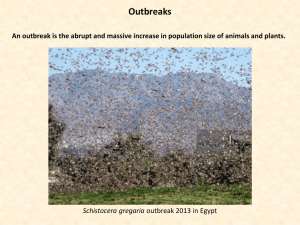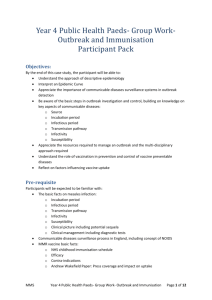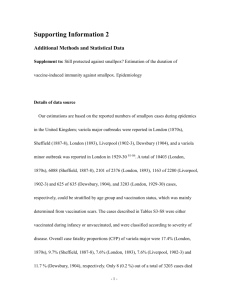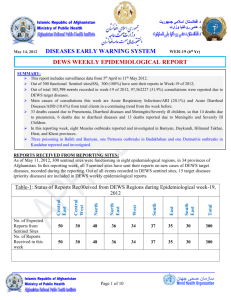Challenges in Measles Outbreak responses MSF Perspectives
advertisement
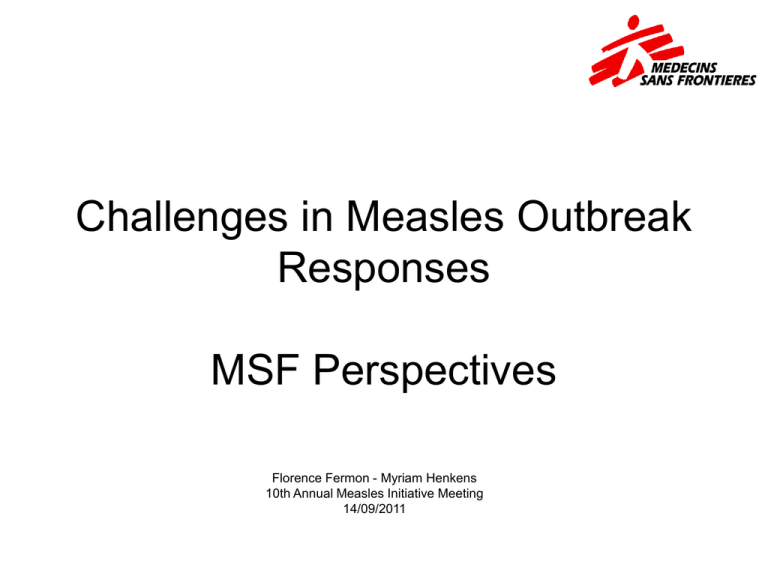
Challenges in Measles Outbreak Responses MSF Perspectives Florence Fermon - Myriam Henkens 10th Annual Measles Initiative Meeting 14/09/2011 Measles resurgence in Africa • Resurgence comes after a period of intensified efforts – Since 2000, routine measles vaccination coverage has increased from an estimated 52% to 85% • In 2009, 30 African countries experienced measles outbreaks – >60,000 reported cases and >1000 reported deaths (WHO) • In 2010, 28 countries experienced measles outbreaks – 223,000 reported cases and 1200 deaths (WHO) • Real numbers of measles cases and deaths are considerably larger than the numbers reported • WHA resolution (RC61) calls for measles elimination in AFRO by 2020 Why the resurgence? 1. Build-up of susceptible children and adolescents 2. Failure to vaccinate rather than vaccine failure 3. Programmatic, political and financial challenges 1. Susceptibility build up • Two sources of immunity • Natural immunity due to infection • Vaccine derived immunity • As vaccination increases • Less circulating virus • Age distribution of cases changes - a natural consequence of the success of vaccination programs – Children (on average) are older when they become infected Different age distributions DRC: 2006 Niger: 2004 In endemic countries, outbreaks are limited to young age classes. Burkina Faso: 2009 Countries in transition are intermediate Malawi: 2010 Outbreaks in countries following “elimination” extend evenly age classes Source: courtesy Matthew Ferrari 2. Failure to vaccinate rather than vaccine failure CV 80 180000 70 Cas de rougeole 160000 60 140000 120000 50 100000 40 80000 30 60000 20 40000 10 20000 0 0 2002 2003 2004 2005 2006 2007 2008 2009 2010 Année Source: VC(WHO 2002-2009 and MICS 2010), cases: Rapports épidémiologiques annuels, 4ème direction, RDC Couverture vaccinale (%) cas 200000 Programmatic, political and financial challenges • Measles victims of MI success and outbreak responses low on politicians and donors agenda • Delays/reluctance in implementing outbreak responses, despite international recommendations • Lack of efficient coordination • Lack of rapid funding • Delays in implementing campaigns - SIAs – despite strong international support (vaccines and operating costs) DRC 2010 => outbreak 2011 MSF & measles outbreak responses Surveillance, treatment, vaccination (when authorized) • 2009: Chad, Ethiopia, DRC, Pakistan, Bangladesh, Nigeria, Sudan, Burkina Faso – 1.4 million vaccinated, 202 000 treated • 2010: Malawi, Chad, DRC, Ethiopia, Yemen, Zimbabwe, Mozambique, Burundi, South Africa, Somalia, Zambia – 4.6 million vaccinated 190 000 treated • 2011: DRC Bangladesh Burundi, Chad, Ethiopia, Kenya, Niger, Somalia, Zambia – already 3 million vaccinated in DRC only, more than 4 million total in August – More than 50 000 treatments in DRC only Measles outbreak responses in Africa 2004-2011 On going Persons vaccinated – MSF - DRC - Burundi - Chad - Ethiopia - Kenya - Niger - Nigeria - Somalia - Zambia 5000000 4500000 4000000 3500000 3000000 2500000 2000000 1500000 1000000 500000 0 2004 2005 2006 2007 2008 2009 2010 2011 Challenges 1. 2. 3. 4. Outbreak detection and recognition Outbreak response plan Outbreak response implementation Outbreak prevention 1. Outbreak detection & recognition • Inaccurate (inflated) vaccination coverage data biased risk assessment • Weak surveillance system late detection of increase in case number • Outbreaks = “failure to vaccinate” late official recognition of outbreak (MOH and main actors) • But outbreaks do and will occur in many countries Measles resurgence in Europe/USA 2. Outbreak response plan • Lack of knowledge of the WHO recommendations • Lack of knowledge of the usefulness of vaccination in outbreak • No standard tools nor technical recommendations for reactive campaigns • Lack of organized technical support (measles >< polio or meningitis) 3. Outbreak response implementation • Coordination between the different partners • Competition with other priorities (polio campaigns) • Free treatment, increased access to treatment • Timely vaccines availability • Timely funding 4. Outbreak prevention • Maintain the number of susceptibles as low as possible • EPI – Flexibility in age range – Immunization included in comprehensive package of care – Special approach to reach children never vaccinated (“reach the un reached”) – Reduce missed opportunities (surveys, health care contacts, etc) – More accurate data in performance, coverage, etc Reaching the unreached Vaccination coverage before and after campaign (6-59 m), Ndjamena, Chad Before Campaign After Campaign 2005 2010 2005 2010 Card % (95% CI) 7.6 (6.3-8.9) 5.5 (4.1-5.6) 53.0 (50.6-55.4) 40.2 (36.9-43.5) Card/Recall % (95% CI) 33.0 (30.9-35.1) 68.7 (66.7-70.7) 80.6 (78.6-82.6) 81.1 (79.8-82.4) Lessons learned, N’djamena, Chad • Chronically low vaccine coverage – Failure to reach older children through routine services – Measles-susceptibles built up and to precipitate the 2010 epidemic • 18% received their first dose in 2010 – previously vaccinated children were easier to reach during the outbreak than unvaccinated children Missed opportunities • CAR - Paoua and Congo Brazza - Betou (MSF - 2010) – limited access to care areas – children were not offered vaccination (in or outpatients) – 0 to 11 m: 65 to 94% were not immunized according to recommendations – 12 to 59 m: 86% to 98% were not immunized and could not be according to the EPI schedules 4. Outbreak prevention (2) • SIA / vaccination campaign – Implement TAG recommendations and adjust age group to local epidemiology – Fixed duration of campaigns >< coverage reached – Adapt SIA intervals to needs – Accurate data collection – Independent coverage surveys – Implementation according to plan (DRC 2010) What could be done? • Outbreak response included as a component of the Measles Initiative • Outbreak response included into national control programs • Renewed political and financial commitment • Strategies to ensure countries implement SIAs according to plan • Improved coordination in country – Meningitis and Polio could be used as example • Limitations / constraints of implementing recommended strategies should be acknowledged What could be done? (2) • Creative strategies – to reduce the missed opportunities, – to reach the unreached • Consider multi Ag campaign (polio, MenA conj, etc) • Develop a risk assessment tool (susceptible population, social determinants, operational strategy) • Develop supporting tools/documents (WHO 2009 recommendations in French, practical accompanying document) • Financial mechanism for rapid response • New vaccines (easy to administer, no cold chain, etc) Acknowledgments • MSF teams – field and HQ • Epicentre (Rebecca Grais, Andrea Minetti) • Matthew Ferrari Thank You For Your Attention
